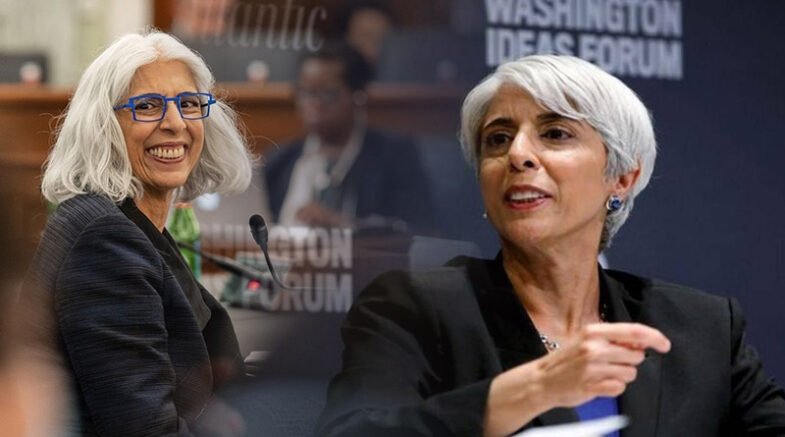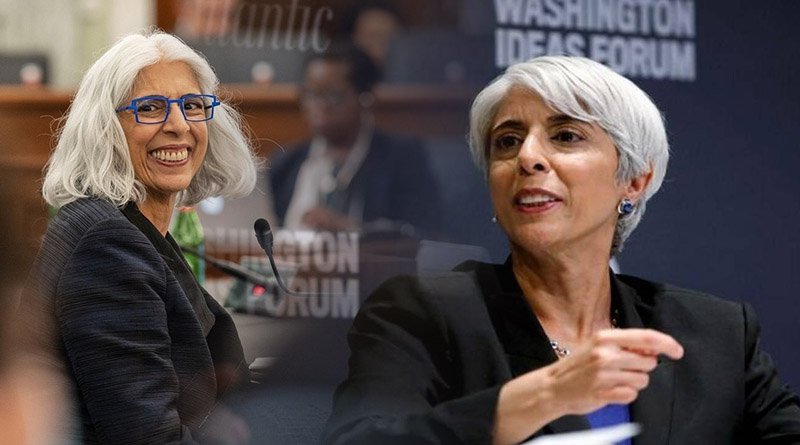An applied physicist, Arati Prabhakar previously led both the US DARPA and the National Institute of Standards and Technology, and she has a long history working in Silicon Valley.

Arati Prabhakar talks to Nature about innovation, the role of science in political decision-making, and regaining control after a scandal. The budget request of US President Joe Biden outlines his vision for a US economy powered by science, innovation, and a bullish brand of industrial policy.
The request comes on the heels of three historic funding bills that allowed for investments in climate and public-health technologies, domestic semiconductor manufacturing, and activities to promote scientific and economic competitiveness with China.
Nature discussed this science-forward road map with Arati Prabhakar, Biden’s chief science adviser and director of the White House Office of Science and Technology Policy (OSTP), who last week granted some of the first media interviews since she was confirmed in early October.
An applied physicist, Arati Prabhakar previously led both the US Defense Advanced Research Projects Agency (DARPA) and the National Institute of Standards and Technology (NIST), and she has a long history working in Silicon Valley.
Both confident and optimistic, despite the challenges facing the world, Arati Prabhakar says the future is ours to write.
How is your experience at NIST and DARPA, as well as in the private sector, playing into your new role at the OSTP?
Arati Prabhakar: Last year, when I got the call from the White House, I was at a point where I had gotten to spend half of my professional life in public service and half in Silicon Valley. Those experiences had given me different vantage points on the complex and really rich innovation system that we have.
The role of science, technology and innovation has always been to blow open new pathways that just weren’t visible before, and [find] new ways to meet our aspirations. That’s really why I came here, because this position is the one place where you sit and look at the entire chessboard. We need to keep making [the innovation system] stronger, but we also need to shape it so that it’s better at meeting our aspirations in these times.
The Biden administration has secured significant legislation to promote science and innovation over the coming decade. What’s next?
Implementing these major investments. That is how the work that our research community has done for decades translates into changes in the lives of Americans; when you can count on the semiconductor supply chains, when there are these rich, robust, wonderful, new jobs and industries. There’s a lot that’s under way, and our job now is to make sure that [this agenda] really does deliver.
The CHIPS and Science Act focused in part on semiconductor supply chains and competitiveness with China. How important is that?
I grew up [academically] in the semiconductor field. It was really clear during [the mid-1980s] that the American semiconductor industry was globalizing, and then got dangerously concentrated in one part of the world [in China]. And for literally decades, I’ve watched us not do anything about that, to the detriment of our national security and economic competitiveness.
And then this amazing thing happened last summer: the CHIPS and Science bill passed. The work that’s on all of our plates now in the administration is to implement it in a way that really does achieve our objective of resilient supply chains that support well-paying jobs.
And it’s not just semiconductors, but climate investments and energy technologies, right?
Absolutely, we don’t have the luxury of just solving one problem at a time. Clean energy is a great example: it is absolutely essential to decarbonize, and deal with the climate crisis, and in doing so we have the opportunity to build industries and jobs here at home.
What about new industries?
One that we’ve put some real work into is biomanufacturing. We have an established biotech industry for pharmaceuticals and a few other products, but research has opened a horizon for using biology to solve many, many more problems with new materials, new chemistries and new structures that the world has never seen before.
This is an industry that will come into the world, and we should take action now and make sure that it happens here in the United States in ways that support jobs and economic growth.
How can the US government compete with China and address national security while also maintaining scientific openness, given renewed tensions between the countries?
We just have to be very clear about two things that are simultaneously true. One is that the geopolitics in our world have changed, that China’s behaviour has changed, that we face some very, very real threats and that we are in a competition.
And at the same time, we need to be clear about our values, that individuals need to be treated fairly and that xenophobia has no place in this conversation. Navigating to practical ways to manage these multiple issues — that’s the work that we’re all doing right now.
US society is sharply divided, politically speaking. Do you worry about science itself becoming a victim of political polarization?
We are in a challenging time for the country. The role that we play in the scientific community is an important one, and in my mind it begins by being really clear about what our contribution is. Science contributes facts. Those facts have to be weighed along with values to make choices.
I do think we can do a little bit better on how we provide information into the fracas. At the end of the day, I think this is a country, and a world, that continues to respect and appreciate what scientists and engineers contribute.
Your predecessor, Eric Lander, resigned after news broke about his mistreatment of staff. What did you tell your staff when you arrived?
By the time I got here, it had been about seven months, and Alondra Nelson was the acting director [of the OSTP]. She did a tremendous job at pouring love on this organization. What I found was a cadre of people who were not only incredibly qualified, but who were running to work in the morning to get big things done, and that is exactly what you want in an organization.
When I walked in the door, I tried to be very clear about my expectations: the way we work is treating every individual with dignity, being direct with each other and working together to achieve these important goals we have. We’ve continued to build from there.
Looking forward, is the world moving fast enough to address the challenges facing humanity?
Well, we’re in the business of science, technology and innovation. Our job is to change the arc of the future, and I think we’re the luckiest people because we have agency to make those dreams come true.
Originally published at Nature
